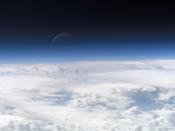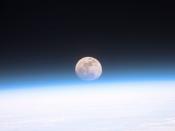The Earth is surrounded by a blanket of air, which we call the atmosphere. It reaches up to a 1000 kilometres from the surface of the Earth, so we are only able to see what occurs fairly close to the ground. Life on Earth is supported by the atmosphere, solar energy, and our planet's magnetic fields. The atmosphere absorbs the energy from the Sun, recycles water and other chemicals, and works with the electrical and magnetic forces to provide a moderate climate. The atmosphere also protects us from high-energy radiation and the frigid vacuum of space.
Remote sensing instruments are used to measure the chemical composition, movement of the atmosphere and density. These instruments are usually located at a distance from the region being measured; usually, either at Earth's surface or on a lower-atmosphere aircraft, or within or above the region of interest; for example, from an orbiting satellite.
Four distinct layers have been identified using remote sensing instruments; these are the troposphere, stratosphere, mesosphere and the thermosphere.
These layers start at the Earth's surface and continue to the Exosphere which merges with the interplanetary medium.
Troposphere: Is the layer that starts at the Earth's surface and continues till about 10kms above it. It contains most of the atmospheric mass; about 80% and most of the water vapour. The Earth's weather is created in this layer and also the temperature falls with increase in altitude at about 6.5 ðC per kilometre to about a minium between -50 and -55 ðC.
Stratosphere: Is the next highest layer which measures about 50kms high. The stratosphere is important because it contains the ozone layer. The Ozone Layer protects the Earth by absorbing out the harmful ultraviolet rays. The temperature increases in altitude due to the ozone layer absorbing the UV rays up to...


